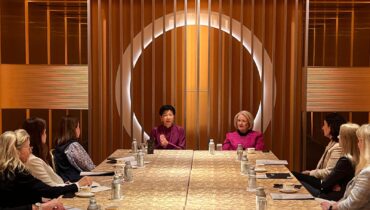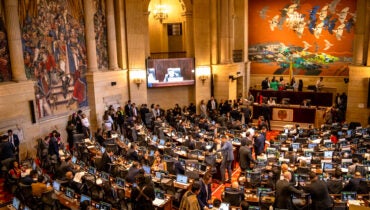On September 25, the international community adopted the Sustainable Development Goals (SDGs), which will guide international action to end poverty, address climate change, improve public health measures and ensure participation, inclusion and prosperity for all people. Women are key actors in all of these areas, and women’s rights and inclusion are integrated throughout the goals. The SDGs are meant to build on the successes of the Millennium Development Goals (MDGs) but also to improve where the MDGs failed; the creation of the SDGs has emphasized the value of inclusion and partnerships, that these goals should be a universal desire for all communities. The adoption of the SDGs initiates a new period of development, health and political work to be done, and it is important to commit not only to these specific goals, but also to a fundamental restructuring of the political, economic, and social structures that prevent women and girls around the world from achieving their full potential.
The fifth SDG is to achieve gender equality and empower all women and girls, which includes nine targets:
- End all forms of discrimination against all women and girls everywhere
- Eliminate all forms of violence against all women and girls in the public and private spheres, including trafficking and sexual and other types of exploitation
- Eliminate all harmful practices, such as child, early and forced marriage and female genital mutilation
- Recognize and value unpaid care and domestic work through the provision of public services, infrastructure and social protection policies and the promotion of shared responsibility within the household and the family as nationally appropriate
- Ensure women’s full and effective participation and equal opportunities for leadership at all levels of decision making in political, economic and public life
- Ensure universal access to sexual and reproductive health and reproductive rights as agreed in accordance with the Programme of Action of the International Conference on Population and Development and the Beijing Platform for Action and the outcome documents of their review conferences
- Undertake reforms to give women equal rights to economic resources, as well as access to ownership and control over land and other forms of property, financial services, inheritance and natural resources, in accordance with national laws
- Enhance the use of enabling technology, in particular information and communications technology, to promote the empowerment of women
- Adopt and strengthen sound policies and enforceable legislation for the promotion of gender equality and the empowerment of all women and girls at all levels
These goals are critical keystones for the advancement of women and girls. Women must be supported to pursue their own goals and interests politically, economically and socially. The targets under Goal 5 provide an appropriate balance of protection and support for agency; three of these targets reference ending a harmful practice in order to protect women and girls, but the rest encourage women’s ability to enter the public sphere in meaningful ways.
Gender and consideration of women’s particular needs have also been integrated into other goals. Goal 1, “No Poverty,” includes a target that reads, “Create sound policy frameworks at the national, regional and international levels, based on pro-poor and gender-sensitive development strategies, to support accelerated investment in poverty eradication actions,” while Goal 4, “Quality Education,” includes, “By 2030, eliminate gender disparities in education and ensure equal access to all levels of education and vocational training for the vulnerable, including persons with disabilities, indigenous peoples and children in vulnerable situations,” as well as a target emphasizing the need for education facilities that are child-, disability-, and gender-sensitive. Women are also included in the effort to double agricultural productivity in Goal 2, “Zero Hunger,” and as beneficiaries of safe, inclusive and accessible green and public spaces in Goal 11, “Make Cities Inclusive, Safe, Resilient and Sustainable.” Goal 6, “Ensure Access to Water and Sanitation for All,” notes that special attention must be paid to the needs of women and girls when working for adequate and equitable sanitation and hygiene for all.
The SDGs follow the significant progress made in the MDGs, and seek to build on the progress made and mobilize new partnerships to create widespread and effective social change. According to the UN, extreme poverty has been cut in half since 1990, enrollment in primary education in developing regions has reached 90 percent, and 3.3 million malaria deaths were prevented in the span of 12 years as a result of the MDGs. However, one in nine people in the world remain hungry. 58 million children remain out of school, and in many countries, women still face discrimination in access to education, work and participation in decision-making.
The SDGs are an opportunity to tackle these remaining issues. The post-2015 development process included an Open Working Group (OWG) through which country delegates and representatives from major humanitarian, non-profit and educational organizations could contribute information, reports and suggestions for the new SDGs. An online e-consultation platform called The World We Want, which also included e-platforms specifically for children and older people, allowed people around the world to provide input on the goals. This was a serious attempt to bring more voices to the table and create goals and targets which were meaningful and reachable. The SDG creation process sought to be as inclusive as possible, and partnerships play a significant role in the vision for how the SDGs will be achieved. Speaking at an event at the Embassy of Italy on October 5, Amina Mohammed, United Nations Secretary-General Ban Ki-moon’s Special Adviser on Post-2015 Development Planning, said that the platform for The World We Want received eight million responses from around the world, and truly inclusive discussions, “not sterile consultations,” were key in creating the SDGs. Every sector of society must be involved for success.
Like the MDGs, the SDGs are a bold statement about the ways in which we hope to reshape the world. They dare to imagine a brighter future for all people, and this is to be applauded. Women are disproportionately vulnerable during conflict, and to disease and marginalization, but they are also powerful actors for creating long-term, sustainable change. Women and women’s rights are not a subset of development; half of the population of the world is critical to achieving every goal and every target. Without women, progress on these goals simply cannot happen.
Like the MDGs, some components of the SDGs are easier for governments, private sector actors and community leaders to support. While eliminating malaria in pregnant women is a relatively clear-cut goal with indicators that are easy to define and measure, ensuring meaningful participation for women is less concrete. The targets in the SDGs for women’s equality currently lack meaningful benchmarks, and the issue remains abstract for many communities. This is not an issue that will be solved through wishful thinking, but takes long-term, sustained action at all levels.
The SDGs are a catalyst for creating innovative partnerships and rethinking the structures that shape our communities. This is an opportunity to more fully examine the structures that restrict women’s agency, and to reshape societies in ways that are inclusive and liberating. The SDGs emphasize powerful and important changes the international community hopes to see around the world, but true change will involve radical transformation in access to legal systems, land tenure, political voice, community leadership and the ability for women to choose their own path. The SDGs may be a tool on paper, but they provide an opening to begin dismantling the institutions and norms that subsume women and men and restrict their choices, aspirations and abilities.
Women are key actors in every sector, in every community and at every level. They are crucial even in places where they seem invisible or where they are victimized. They are key to building sustainable development and opening opportunities for all people to participate meaningfully. The SDGs should be viewed as a call to action and a catalyst for building partnerships, coalitions and movements to reshape fundamentally the structures that prevent women and the world from reaching their health, environmental, political and economic development aspirations.


